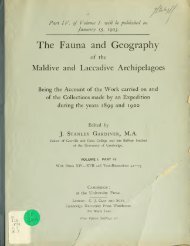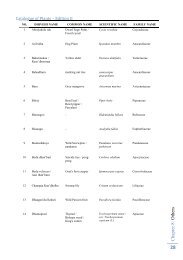Download - WordPress – www.wordpress.com
Download - WordPress – www.wordpress.com
Download - WordPress – www.wordpress.com
Create successful ePaper yourself
Turn your PDF publications into a flip-book with our unique Google optimized e-Paper software.
THE ENTEROPNEUSTA. 659only the merest traces of a lumen. As is often the case with the collar cord, when thelumen shews a marked tendency to occlusion, the dorso-ventral diameter as seen in transversesection tends to be<strong>com</strong>e relatively gi-eat as <strong>com</strong>pared with the transverse diameter (PI. XLIV.fig. 29). The number of the dorsal mots is xrvy variable There may be as few as one,though four seems to be the maximum.The cornua of the nuchal skeletim arc cm the wlicile loiitr for memlxTs of this c-eniisbut shew a considerable amount of variation. 'J'hey may extend (jver only \ of the collarlength, or their length may be ecjual nearl}- to ^ that of the c(.)llai-.Trunk. The branchial jjortion (if the oesophagus is of about the same size as theventral part. The relative length ol' the branchial region as <strong>com</strong>pared with the collar lengthis short, it being seldom more than half as long again as the latter and sometimes evenless. In the large specimen figured on PL XXXVII. fig. !J, however, it was rather morethan three times the collar length.The post-branchial gi-oove on the other hand is longer than usual, averaging betweeni and I the length of the branchial region.The genital folds are somewhat small (PL XLVI. figs. .52 and .5(J) and be<strong>com</strong>e mereridges in the region of the post-branchial groove (PI. XLVI. fig. 58).SOME ANATOMICAL POINTS.As Spengel in his latest publication ('03) differs on one or two jxiints fnjni Willeyit may be worth devoting a few lines to them. In two of these cases, the pygochord andthe lateral septa, I find myself in agreement with Spengel rather than Willey.The pygochord is a structure on which Willey has laid some stress, describing it as"a longitudinal, s(jlid, supporting band" ('99, p. 248), and evidently seeing in it a skeletalstructure for the support of the caudal region. On the ground of its minute proportionsSpengel ('03, p. 317) dissents from Willey's interpretation, and one cannot help agreeingwith Spengel in refusing to regard such a small and rudimentary structui'e as of anyimportance from this jwint of view. As Spengel remarks we have absolutely no knowledgeof the function (,)f this apparently vestigial structure, and it is with some diffidence thatI venture to suggest that it may be the remains of a ventral si])hon which was at onetime of functional impoi'tance but now vestigial. The occuirence of such a sii)hon, whatevermay be its exact function, is <strong>com</strong>mon among sand-feeding animals. Similar structures occur inthe Echinoidea, in the Capitellidae, and in certain Chaetopoda such as Thallasema and Echiurus— all creatures which derive their nutriment fi'om among the large quantities of sand continuallypassing through the alimentary canal. The conditi






